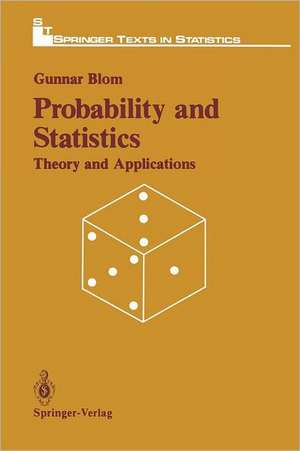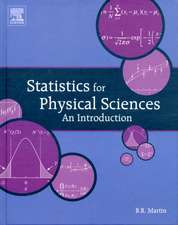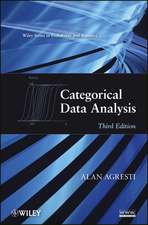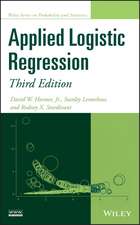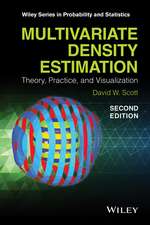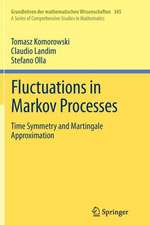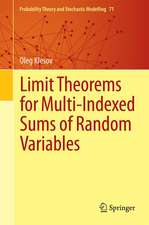Probability and Statistics: Theory and Applications: Springer Texts in Statistics
Autor Gunnar Blomen Limba Engleză Paperback – 27 sep 2011
Din seria Springer Texts in Statistics
-
 Preț: 400.60 lei
Preț: 400.60 lei - 15%
 Preț: 559.21 lei
Preț: 559.21 lei - 18%
 Preț: 903.62 lei
Preț: 903.62 lei - 20%
 Preț: 764.93 lei
Preț: 764.93 lei - 20%
 Preț: 643.55 lei
Preț: 643.55 lei - 20%
 Preț: 717.71 lei
Preț: 717.71 lei - 13%
 Preț: 486.97 lei
Preț: 486.97 lei - 20%
 Preț: 633.82 lei
Preț: 633.82 lei - 20%
 Preț: 697.48 lei
Preț: 697.48 lei - 15%
 Preț: 676.86 lei
Preț: 676.86 lei - 15%
 Preț: 621.10 lei
Preț: 621.10 lei - 20%
 Preț: 700.51 lei
Preț: 700.51 lei - 18%
 Preț: 743.11 lei
Preț: 743.11 lei - 18%
 Preț: 695.29 lei
Preț: 695.29 lei -
 Preț: 253.64 lei
Preț: 253.64 lei - 17%
 Preț: 525.27 lei
Preț: 525.27 lei - 17%
 Preț: 428.39 lei
Preț: 428.39 lei - 19%
 Preț: 571.81 lei
Preț: 571.81 lei - 20%
 Preț: 567.30 lei
Preț: 567.30 lei -
 Preț: 359.54 lei
Preț: 359.54 lei -
 Preț: 477.28 lei
Preț: 477.28 lei - 20%
 Preț: 570.35 lei
Preț: 570.35 lei - 15%
 Preț: 650.86 lei
Preț: 650.86 lei - 19%
 Preț: 626.93 lei
Preț: 626.93 lei - 18%
 Preț: 948.29 lei
Preț: 948.29 lei -
 Preț: 500.46 lei
Preț: 500.46 lei - 18%
 Preț: 746.59 lei
Preț: 746.59 lei -
 Preț: 403.75 lei
Preț: 403.75 lei -
 Preț: 403.37 lei
Preț: 403.37 lei -
 Preț: 394.71 lei
Preț: 394.71 lei - 18%
 Preț: 946.69 lei
Preț: 946.69 lei - 15%
 Preț: 578.67 lei
Preț: 578.67 lei - 15%
 Preț: 702.54 lei
Preț: 702.54 lei -
 Preț: 407.01 lei
Preț: 407.01 lei - 18%
 Preț: 895.89 lei
Preț: 895.89 lei - 15%
 Preț: 600.80 lei
Preț: 600.80 lei - 23%
 Preț: 684.78 lei
Preț: 684.78 lei - 19%
 Preț: 543.08 lei
Preț: 543.08 lei - 15%
 Preț: 595.86 lei
Preț: 595.86 lei -
 Preț: 423.18 lei
Preț: 423.18 lei - 15%
 Preț: 656.10 lei
Preț: 656.10 lei - 15%
 Preț: 682.90 lei
Preț: 682.90 lei - 18%
 Preț: 814.43 lei
Preț: 814.43 lei -
 Preț: 402.76 lei
Preț: 402.76 lei -
 Preț: 408.54 lei
Preț: 408.54 lei
Preț: 503.04 lei
Preț vechi: 591.82 lei
-15% Nou
Puncte Express: 755
Preț estimativ în valută:
96.26€ • 102.93$ • 80.26£
96.26€ • 102.93$ • 80.26£
Carte tipărită la comandă
Livrare economică 18 aprilie-02 mai
Preluare comenzi: 021 569.72.76
Specificații
ISBN-13: 9781461281580
ISBN-10: 146128158X
Pagini: 372
Ilustrații: XI, 356 p.
Dimensiuni: 155 x 235 x 20 mm
Greutate: 0.52 kg
Ediția:Softcover reprint of the original 1st ed. 1989
Editura: Springer
Colecția Springer
Seria Springer Texts in Statistics
Locul publicării:New York, NY, United States
ISBN-10: 146128158X
Pagini: 372
Ilustrații: XI, 356 p.
Dimensiuni: 155 x 235 x 20 mm
Greutate: 0.52 kg
Ediția:Softcover reprint of the original 1st ed. 1989
Editura: Springer
Colecția Springer
Seria Springer Texts in Statistics
Locul publicării:New York, NY, United States
Public țintă
ResearchCuprins
1 Introduction to Probability Theory.- 1.1. On the Usefulness of Probability Theory.- 1.2. Models, Especially Random Models.- 1.3. Some Historical Notes.- 2 Elements of Probability Theory.- 2.1. Introduction.- 2.2. Events.- 2.3. Probabilities in a General Sample Space.- 2.4. Probabilities in Discrete Sample Spaces.- 2.5. Conditional Probability.- 2.6. Independent Events.- 2.7. Some Theorems in Combinatorics.- 2.8. Some Classical Problems of Probability1.- 3 One-Dimensional Random Variables.- 3.1. Introduction.- 3.2. General Description of Random Variables.- 3.3. Distribution Function.- 3.4. Discrete Random Variables.- 3.5. Some Discrete Distributions.- 3.6. Continuous Random Variables.- 3.7. Some Continuous Distributions.- 3.8. Relationship Between Discrete and Continuous Distributions.- 3.9. Mixtures of Random Variables.- 4 Multidimensional Random Variables.- 4.1. Introduction.- 4.2. General Considerations.- 4.3. Discrete Two-Dimensional Random Variables.- 4.4. Continuous Two-Dimensional Random Variables.- 4.5. Independent Random Variables.- 4.6. Some Classical Problems of Probability1.- 5 Functions of Random Variables.- 5.1. Introduction.- 5.2. A Single Function of a Random Variable.- 5.3. Sums of Random Variables.- 5.4. Largest Value and Smallest Value.- 5.5. Ratio of Random Variables.- 6 Expectations.- 6.1. Introduction.- 6.2. Definition and Simple Properties.- 6.3. Measures of Location and Dispersion.- 6.4. Measures of Dependence.- 7 More About Expectations.- 7.1. Introduction.- 7.2. Product, Sum and Linear Combination.- 7.3. Arithmetic Mean. Law of Large Numbers.- 7.4. Gauss’s Approximation Formulae.- 7.5. Some Classical Problems of Probability1.- 8 The Normal Distribution.- 8.1. Introduction.- 8.2. Some General Facts About the Normal Distribution.- 8.3. Standard Normal Distribution.- 8.4. General Normal Distribution.- 8.5. Sums and Linear Combinations of Normally Distributed Random Variables.- 8.6. The Central Limit Theorem.- 8.7. Lognormal Distribution.- 9 The Binomial and Related Distributions.- 9.1. Introduction.- 9.2. The Binomial Distribution.- 9.3. The Hypergeometric Distribution.- 9.4. The Poisson Distribution.- 9.5. The Multinomial Distribution.- 10 Introduction to Statistical Theory.- 10.1. Introduction.- 10.2. Statistical Investigations.- 10.3. Examples of Sampling Investigations.- 10.4. Main Problems in Statistical Theory.- 10.5. Some Historical Notes.- 11 Descriptive Statistics.- 11.1. Introduction.- 11.2. Tabulation and Graphical Presentation.- 11.3. Measures of Location and Dispersion.- 11.4. Terminology.- 11.5. Numerical Computation.- 12 Point Estimation.- 12.1. Introduction.- 12.2. General Ideas.- 12.3. Estimation of Mean and Variance.- 12.4. The Method of Maximum Likelihood.- 12.5. The Method of Least Squares.- 12.6. Application to the Normal Distribution.- 12.7. Application to the Binomial and Related Distributions.- 12.8. Standard Error of an Estimate.- 12.9. Graphical Method for Estimating Parameters.- 12.10. Estimationof Probability Function, Density Function and Distribution Function1.- 12.11. Parameter with Prior Distribution1.- 13 Interval Estimation.- 13.1. Introduction.- 13.2. Some Ideas About Interval Estimates.- 13.3. General Method.- 13.4. Application to the Normal Distribution.- 13.5. Using the Normal Approximation.- 13.6. Application to the Binomial and Related Distributions.- 14 Testing Hypotheses.- 14.1. Introduction.- 14.2. An Example of Hypothesis Testing.- 14.3. General Method.- 14.4. Relation Between Tests of Hypotheses and Interval Estimation.- 14.5. Application to the Normal Distribution.- 14.6. Using the Normal Approximation.- 14.7. Application to the Binomial and Related Distributions.- 14.8. The Practical Value of Tests of Significance.- 14.9. Repeated Tests of Significance.- 15 Linear Regression.- 15.1. Introduction.- 15.2. A Model for Simple Linear Regression.- 15.3. Point Estimates.- 15.4. Interval Estimates.- 15.5. Several y-Values for Each x-Value.- 15.6. Various Remarks.-16 Planning Statistical Investigations.- 16.1. Introduction.- 16.2. General Remarks About Planning.- 16.3. Noncomparative Investigations.- 16.4. Comparative Investigations.- 16.5. Final Remarks.- Appendix: How to Handle Random Numbers.- Selected Exercises.- References.- Tables.- Answers to Exercises.- Answers to Selected Exercises.
